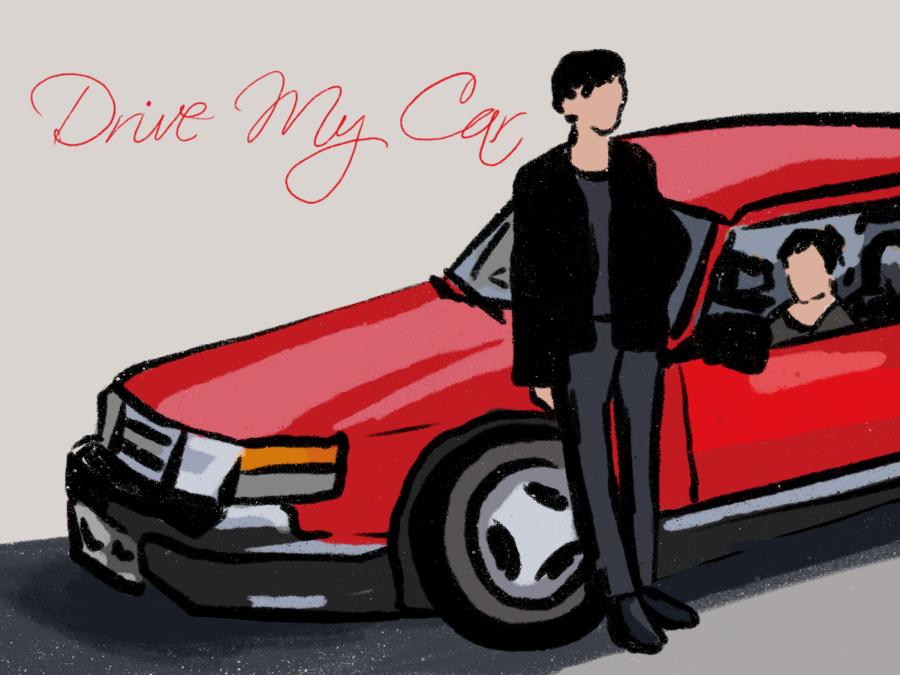Review: ‘Drive My Car’ is a winding and delicate rumination on loss and love
Best international feature winner “Drive My Car” is a profound film that deals with how people communicate.
The Oscar-nominated “Drive My Car,” by Ryusuke Hamaguchi, was adapted from a short story by Haruki Murakami. The film is available to stream on HBO Max. (Staff Illustration by Susan Behrends Valenzuela)
March 28, 2022
2021 was truly a fantastic year for Japanese filmmaker Ryûsuke Hamaguchi, who released not one but two major films last year to critical acclaim. Both “Wheel of Fortune and Fantasy” and “Drive My Car” have been universally praised for their realistic characters, naturalistic storytelling, and engrossing dialogue and performances. The latter racked up four Oscar nominations — including one for best picture — tying with Akira Kurosawa’s “Rashomon” for the most nominations a film from Japan has ever garnered. It went on to win best international feature.
“Drive My Car” is also one of only six films — the others being “Goodfellas,” “Schindler’s List,” “L.A. Confidential,” “The Social Network” and “The Hurt Locker” — to earn best picture nominations from all three major U.S. critic groups, and the only non-English language film among those six.
Watching “Drive My Car” is an inimitable experience. The film requires patience from its viewers — for example, the opening credits only roll 40 minutes in — and its three-hour runtime is likely to turn away impatient viewers. However, “Drive My Car” provides an intensely fulfilling and introspective experience unlike any other. Hamaguchi’s meticulous directorial style truly comes into play here; the film unfolds slowly and methodically, creating an almost meditative experience. As a storyteller, Hamaguchi understands that so much of life occurs in the everyday and seemingly mundane. It is this philosophy that marks “Drive My Car” as a masterpiece in observing the subtle moments between emotionally restrained characters.
The film is primarily adapted from a roughly 40-page short story of the same name by Haruki Murakami, although it also incorporates elements from other Murakami stories. It also incorporates significant passages from Anton Chekhov’s “Uncle Vanya” in multiple languages, including Japanese, Mandarin and Korean Sign Language. Through his unique staging of “Uncle Vanya,” in which Hamaguchi has multiple actors speaking different languages interact with each other, he seems to be proposing a question to the audience: How much can people speaking different languages understand each other?
In many ways, “Drive My Car” is about the complexity of communication. The emotions of its main characters in the film are sparse at times as they struggle to come to terms with their emotions. The protagonist, Yūsuke Kafuku (Hidetoshi Nishijima), is a quiet theater director grappling with the recent passing of his wife and her infidelity. After being called to direct an adaptation of “Uncle Vanya,” he meets Misaki Watari (Tôko Miura), a similarly reserved young woman assigned as his chauffeur.
Both Nishijima and Miura give impactful performances as two individuals who are in no hurry to reveal themselves to each other or the audience. When they finally do, the audience shares their cathartic revelations as they begin to find comfort in each other.
A core thematic image that recurs throughout the film is, predictably, the car. The film’s most emotionally resonant dialogues occur during conversations in cars. Though it might be surprising when one considers the seemingly static visual nature of these settings, they are also the setting for some of the film’s most striking images.
Hamaguchi cites Iranian filmmaker Abbas Kiarostami as a major influence for these scenes. The car, according to both directors, is an intimate place of internal journey and introspection. In an interview, Hamaguchi explains that inside these moving cars, he believes that we tend to reveal things we wouldn’t in other situations. The passengers face the same direction and are not looking at each other, creating a space in which, Hamaguchi believes, they are “forced to look inwards as they’re talking.” As the film progresses, Kafuku and Watari grow closer in this intimate space, bringing them to revelations about their losses and helping them come to terms with their difficult pasts.
“Drive My Car” is a film that lingers with you. Hamaguchi’s eloquent and profound testament to grief, art and human connection is essential viewing — especially if you can see it in a theater.
“Drive My Car” is playing now in theaters and is also available to stream on HBO Max.
Contact Stephanie Wong at [email protected].
























































































































































